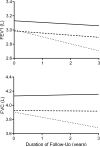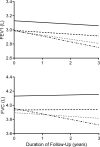The effect of HIV infection on longitudinal lung function decline among IDUs: a prospective cohort
- PMID: 23299176
- PMCID: PMC3953568
- DOI: 10.1097/QAD.0b013e32835e395d
The effect of HIV infection on longitudinal lung function decline among IDUs: a prospective cohort
Abstract
Objective: As survival with HIV infection improves, HIV-infected individuals appear to be susceptible to development of chronic diseases, including restrictive and obstructive lung diseases. We sought to determine the independent association of HIV infection on lung function decline.
Design: Longitudinal analysis of the AIDS Linked to the Intravenous Experience study, an observational cohort of current and former IDUs.
Methods: Generalized estimating equations were used to determine the effects of markers of HIV infection on adjusted annual change in forced expiratory volume in one second (FEV1) and forced vital capacity (FVC).
Results: A total of 1064 participants contributed 4555 spirometry measurements over a median follow-up time of 2.75 years. The mean age of the cohort was 48 years; nearly, two-thirds were men and 85% current smokers. After adjustment, the overall annual decline of FEV1 and FVC between HIV-infected and uninfected persons did not differ. However, there was a 76 ml/year greater rate of decline in FEV1 and 86 ml/year greater rate of decline in FVC among HIV-infected participants with viral load more than 75 000 copies/ml compared with HIV-uninfected individuals (P < 0.01). Similarly, HIV-infected individuals with CD4 cell count less than 100 cells/μl had a 57 ml/year more rapid decline in FEV1 and 86 ml/year more rapid decline in FVC than HIV-uninfected participants (P = 0.018 and P = 0.001, respectively).
Conclusion: Markers of poorly controlled HIV disease are independently associated with accelerated annual lung function decline, with decrements in both FEV1 and FVC. These findings highlight the need for optimized HIV antiretroviral therapy in addition to smoking cessation among HIV-infected individuals with tobacco dependence.
Figures



Comment in
-
HIV infection and lung function decline: challenges, clinical implications, and new questions.AIDS. 2013 May 15;27(8):1345-7. doi: 10.1097/QAD.0b013e3283601082. AIDS. 2013. PMID: 23925381 No abstract available.
References
-
- Walensky RP, Paltiel AD, Losina E, Mercincavage LM, Schackman BR, Sax PE, et al. The survival benefits of AIDS treatment in the United States. J Infect Dis. 2006;194:11–19. - PubMed
-
- Braithwaite RS, Justice AC, Chang CC, Fusco JS, Raffanti SR, Wong JB, et al. Estimating the proportion of patients infected with HIV who will die of comorbid diseases. Am J Med. 2005;118:890–898. - PubMed
-
- Wood E, Hogg RS, Lima VD, Kerr T, Yip B, Marshall BD, et al. Highly active antiretroviral therapy and survival in HIV-infected injection drug users. JAMA. 2008;300:550–554. - PubMed
Publication types
MeSH terms
Grants and funding
LinkOut - more resources
Full Text Sources
Other Literature Sources
Medical
Research Materials

